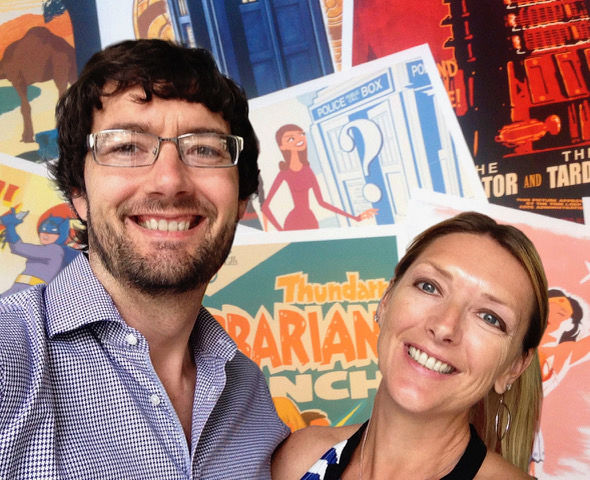

A big part of making a comic/graphic novel is having it colored (assuming you're going to be doing a colored book). And since for many coloring and colorists are often a bit of a mystery, this post has been provided to share some basic information and introduction into the craft and process in general with the idea of giving you enough to be more informed to continue your own search as needed.
Brian & Kristy Miller are the founders of digital color studio Hi-Fi Colour Design. The team at Hi-Fi colors comics for a broad spectrum of comic book publishers including Dark Horse, DC, IDW, Image, and Marvel. Brian was gracious enough take a moment out of his busy schedule to answer some questions about himself and his work.
For those reading this who might not know, what exactly does a colorist do when it comes to coloring comics? Could you go into a bit of the process?
A comic book colorist starts with the back and white artwork created by the artist(s) and then paints in the colors along with all the shading and any special effects needed. I like to start be coloring the backgrounds first and creating an environment for the characters to inhabit. Once I’ve worked out all the color selection and lighting then I will add color rendering to the characters. I use Adobe Photoshop for the majority of comic projects although sometimes I will utilize apps on my iPad Pro like Procreate and others. I try not to be locked in to any one particular approach as the tools available are updated and change frequently.
Is there a way people can search for colorists for their project? A website or certain locations they’d be more likely to find them?
If you see coloring you like in a comic book search for that colorist online. Odds are they have an online portfolio or social media presence and would be happy to hear from you. Another way to find colorists would be through the popular online portfolio sites, social media, and creative marketplaces.
While every colorist can vary on their turnaround time, what do you say is a pretty standard timeline for coloring pages in general?
That’s a great question. Depending upon the project and the level of detail most professional colorist will color an average of 1-3 pages per day. I’m a big believer in focusing on the visual storytelling and quality over raw speed but, of course, print deadlines will determine the speed at which any comic needs to be colored.
As a colorist, how do you prefer people reach out to you with possible project proposals? And what do you wish others knew before they did so?
When people see the name Hi-Fi on projects from big publishers they can be shy about reaching out but we work on some amazing small press and indy press comics too. If I could share some tips for making first contact with a colorist they would be:
Communicate the size of the project. How many pages per issue and how many issues need to be colored?
Have at least 3-5 examples of the artwork to be colored ready to share with the colorist so they can see the style of artwork.
Be ready to describe the story and characters in 2-4 sentences. This is your, “elevator pitch” to help the colorist to understand and share your vision.
If you loved a specific comic they worked on, (or even a comic they didn’t color), be sure to mention it up-front to help the colorist understand your expectations for the coloring.
If you have a budget range per issue or per page communicate that clearly. Don’t be shy about talking about money. If they rate is too low they will let you know or kindly pass on the project. Sometimes they may even recommend an up-and-coming colorist who could help instead. It is a small community and we tend to know one another and help each other when we can with referrals.
Set expectations and agree to milestones and deadlines before starting work. This goes both ways. If the art is late for any reason, then the deadline for colors may need to be adjusted.
Do you ever color books differently? Say, to achieve a certain look or mood or feel to something other than a “standard/regular” graphic novel or comic book? And if so, how is that determined? More of a “gut instinct” on your part or more of a collaboration or even dictation from the one heading up the project?
At Hi-Fi we tend to approach each project as being a unique visual storytelling experience. I will review the artwork and read the plot and really think about what the story is asking for or demanding from the colors. I reflect on my past experiences and the experiences of the Hi-Fi team and then we craft a look and feel for each particular project. As an example, much of our work for the well known Superhero books tends to be big, bold, and colorful while colors for a western or a mystery book might be more subtle and moody. I approach the color like from the viewpoint of a cinematographer thinking about light, shadow, and mood as well as color selection.
For those looking to get into the business of coloring do you have any advice you’d like to share?
The industry has changed so much since I started. Tools like Mac computers and Adobe Photoshop are much more accessible now, allowing almost every creative person the opportunity to explore the world of comic coloring. The best advice I can give is don’t be in a hurry and don’t work for free out of desperation for exposure. Take your time to develop your visual storytelling and technical coloring skills. Put your best color work on your social media for people to see and make sure you enjoy what you are creating. Your joy will come through on the page and other creators/editors will take notice. That said, not every athlete makes it to the big leagues and not every musician becomes a pop-star. Likewise not every creator makes it in comics. You have to be able to accept rejection when it comes and celebrate the opportunities to contribute as a colorist on professional published comics.
What, if anything, is one of your most favorite things about coloring comics/graphic novels?
The best part of working in comics is collaborating with other creators. Writers, pencillers, inkers, letterers, and editors all work together with the colorist to craft new and exciting stories. Sometimes you just “click" with another creator and that is when the magic happens. What you produce together is better than what either of you could create apart. It’s a very special feeling that only comes around once in a while but when it happens you know the comic you are working on is going to be very special.
Thanks, Brian!
To find out about Brian Miller and the rest of the Hi-Fi team you can follow them at: https://infoc383.myportfolio.com/

Get updates on the latest news, book releases, deals, signings, and more. No spam. No hassles. All free. Sign up today.